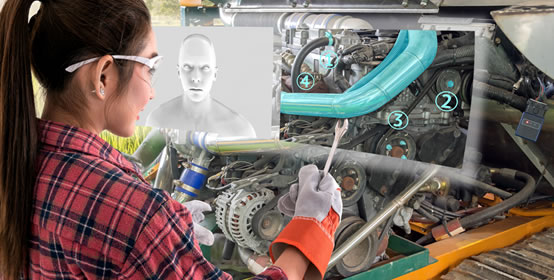
Virtual reality has been anticipated and discussed for years, but the real focus that should be getting people excited is it’s sister technology AR. Augmented reality will shape a new era in the manufacturing industry. Most notably, this advanced tech will cause changes in areas like quality assurance and compliance. This technology will have sweeping effects that radically improve production, training and maintenance.
Augmented reality involves layering digital images onto an individual’s real-world view using a smartphone, headset or other device. The technology shocked the mainstream last year when the hit mobile-app ‘Pokémon Go!’ became the latest newsworthy trend. The game involves superimposing the cute characters into the real world by utilizing the smartphone’s camera and video capabilities. Users can go to real-world locations, catch the characters and play virtually and locally simultaneously. Another such app, Augment, gives individuals the ability to see what furniture will look like in their home before purchasing it. While this catchy tech obviously has great entertainment potential, the real value lies in its application in areas like manufacturing.
AR programs greatly improve production. One aspect of this technology is that it allows employers to quickly identify and locate problems or hold-ups in development. Many programs have the advanced ability to identify the potential for problems and help employees correct the issue before it happens. These types of programs allow all employees to have instant and real-time data streams. This greatly increases awareness and cooperation among workers.
This type of technology is already in use by companies like Airbus. Since 2011, they have utilized a Smart Augmented Reality Tool which includes an error-detecting installation guide. The guide works by superimposing an ideal and completed assembly design over the real-life product so that employees can visually detect flaws with greater accuracy. This prevents any incorrectly built products from passing into operation.
Augmented reality tutorials make training more efficient, timely, cost-effective and simple. Newly-learning team members can substitute real-life experience with AR simulations. These simulations boost learning and hands-on skills that could otherwise only be learned on-the-job. High-tech machinery can be built by those still training with the use of on-screen instructions, voice messages, text and other visual guides superimposed onto the real-life object.
These types of training techniques have already been put to the test by top companies. The top defense contractor Lockheed Martin demonstrated that such augmented reality tutorials increased their engineers’ accuracy to 96 percent. Their production rate was increased by about 30 percent. Similarly, Bosch used the Oculus Rift headset and AR technology to train over 10,000 technicians. Graphics that depict how various pieces fit together, how to assemble and disassemble parts and how other objects that might connect make these AR guided tutorials unmatched in efficiency.
In the same way that guided tutorials create highly efficient training manuals, AR tutorials facilitate quick and accurate maintenance repairs. A traditional database can store large amounts of data, but the AR technology makes the information more accessible, easy to use and more contextually appropriate.
Scheduled maintenance also benefits from the use of such augmented reality QR code readers. Combining AR and IoT technology with algorithms allows employees to simply scan a code and produce data about the object’s location, maintenance schedule, maintenance record and other data. The code can store instructional manuals, operation codes or other technical information. Videos are superimposed over the real object that can take employees through each step of the process ensuring both accuracy and efficiency each time.
Combining such technologies may still seem theoretical or futuristic, but the technology is already developed and in-use by Vuforia Studio software. The program allows the user to print off sticker labels, or “ThingMarks”, and attach it to various objects. Employees scan the ThingMark through Vuforia’s app and are directly connected to a massive database. When scanned, a ThingMark-ed pressure valve will appear to the employee with accurate real-time pressure and temperature readings hovering above the object.
The incredible effects that such augmented reality will have production, training and maintenance will inevitably change the manufacturing industry as a whole and usher in a modern-day revolution. A 2015 survey by PwC revealed that over one third of US manufacturers already use augmented reality technology or were planning to implement it by 2018. This means that within the next few years, we should be seeing a massive roll-out of this industry altering tech and the implications discussed above will gradually become mainstream.